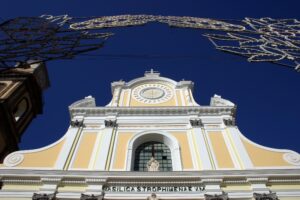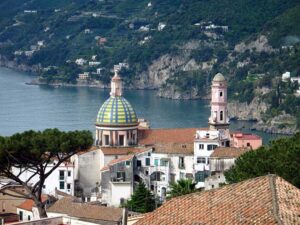CHIESA DELLA MADONNA DELLE GRAZIE
“The church with the porch” (2)
The Church of Madonna delle Grazie (Our Lady of Grace) stands in one of the most picturesque areas of Ravello. It is placed on the eastern part of the town, the one that overlooks the towns of Minori and Maiori.
In addition to its scenic value, the area has been of fundamental importance over time. Documentary sources show that the area, known as “Pendolo,” was a kind of detached district of the ancient city of Ravello, with intense social and economic activity. This importance is demonstrated by the construction of a wall that separated the “Pendolo” area from the rest of the town.
The church, therefore, was the place of worship for the families of that specific area, and it was through the initiative of a local nobleman that the building (which was initially dedicated to St. Matthew) was founded in the 12th century. Until 1733 the structure is known by its original name of San Matteo/St. Matthew al Pendolo. Later, the place changed its dedication to Our Lady of Grace/Santa Maria delle Grazie.
The simplicity of the interior facings, the predilection for the white color of the roofing, and the reused marble columns make the building an illustrative example of the local Romanesque style. In addition, the domed shape of the apses creates a spontaneous association of the building with other Ravello churches.
The strength of the church is light. Thanks to the openings placed at the top of the central nave, natural daylight manages to filter in creating a sober and recollecting atmosphere.
Of relevant importance is the Cappelluccia (little chapel), located at the side of the entrance, in which remain traces of a fresco depicting the Madonna breastfeeding, the Agnus Dei, and San Cosma, a character dear to the spirituality of the Ravello community.
In the small sacristy is preserved the former covering of the front face of the altar (paliotto*), restored in the 1930s.
Adjacent to the church, there are a small portico, which connects the sacred area of the interior with the exterior, and a small bell tower structured on two levels, which recalls the motifs and forms of the other liturgical buildings of the place.





